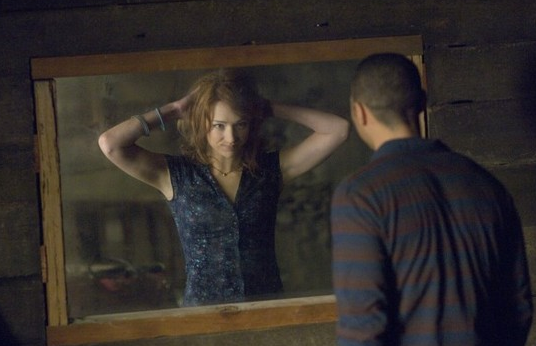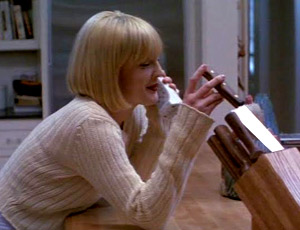Burning Questions: Can Horror Keep a Straight Face?
 Tuesday, April 17, 2012 at 4:08PM
Tuesday, April 17, 2012 at 4:08PM Michael C. here to talk horror and I left the spoilers back in civilization where they can't be reached. If Drew Goddard’s Cabin in the Woods ends up the cult favorite it is so clearly destined to be, it will not be simply because Whedon’s acolytes turn up automatically or because the film is tremendous fun that efficiently presses every horror geek button known to man. Cabin has a lock on cult status because it so perfectly captures a moment in time.
 Cabin in the Woods can't stop looking at Horror's reflections
Cabin in the Woods can't stop looking at Horror's reflections
If Scream’s purpose in ’96 was to take the piss out of the slasher movie, Goddard's film uses the slasher flick as a jumping off point to take on the whole horror genre, top to bottom. In this era, when even non-horror fans chuckles when the dead teenager clichés make their appearances on cue, Cabin pulls back the curtain on the machinations of the whole show until it resembles a viral supercut of the horror genre’s interchangeable, formulaic parts, and it expects the audience to laugh with recognition at each one.
So if audiences are as savvy as the Cabin's filmmakers expect them to be one wonders: Have horror movies lost the ability to play it straight? Have they given up trying to surprise a fanbase that is perpetually in on the joke?
On a purely mercenary economic level, sincerity should win out every time since the audience looking to be genuinely involved is always going to dwarf the ironic detachment crowd. Look no further than the record numbers put up by AMC’s Walking Dead, which, whatever its numerous flaws, doesn’t lack for earnestness. And admittedly, it’s not hard to come up with examples to contradict this idea. This year has already seen the well-received classical ghost story The Woman in Black, and just recently there was Tom Alfredson’s masterful Let the Right One In and its better-than-anyone-had-reason-to-expect remake.
But still even a cursory glance over the upcoming cinematic landscape makes these films look like members of an endangered species, what with the rash of Emo monsters, lame Johnny Depp monsters and the one-two punch of horror movie ass-kickers Abe Lincoln and Edgar Allen Poe. Even if Abe Lincoln: Vampire Hunter plays it’s Confederate ghouls plot as straight as Glory there is no way to get around meta mashup cuteness of the concept - to say nothing of Poe running around the forest with a pistol in each hand like he’s auditioning for the League of Extraordinary Gentlemen, when his character should rightly be busy dying of tuberculosis.
One can argue that the much-reviled torture films of the past decade at very least played their violence with a grim seriousness, but this sub-genre’s game of grisly one-upsmanship was always a barrier between the film and the audience. The escalating silliness of these movies allowed audiences a way to safely distance themselves from the on-screen carnage. The same goes for the wave of horrific foreign releases like France’s Martyrs, which has picked up the torture baton and are now on a mission to make American audiences look like delicate hothouse flowers for being shocked by the likes of Hostel.
 the divisive "Martyrs" from France(I read that the producers seek to remake Martyrs for American audiences. Uh…good luck with that)
the divisive "Martyrs" from France(I read that the producers seek to remake Martyrs for American audiences. Uh…good luck with that)
Now that the found footage horror film has replaced torture porn as Hollywood’s ridiculously profitable mass-market horror film of choice, it would appear to be a step in the right direction. It’s as if audiences have become so aware of the mechanics of scares that the only way to provoke a response is by stripping horror down to the total artlessness of the Paranormal Activity films. Yet this technique can quickly go from stylistic innovation to distracting gimmick, especially when duds like The Devil Inside exploit the technique in order to lazily make a wide release profit on direct-to-video quality production.
One of the genre's most encouraging developments has been those movies which became so meta that they went full circle back into sincerity. Just watch Ti West’s '09 retro-flick House of the Devil, which does such a superb job aping the rhythms of a 80’s schlock-fest that it manages to shake of the last quarter century of genre tics and be a great economical little chiller. It makes me hope some enterprising director will be inspired by the success of The Artist and create a black and white creepshow which reaches all the way back to the style of Murnaus’s Nosferatu or Fritz Lang’s M, ditching 90 years worth of horror cliches in the process.
 House of the Devil goes full circle
House of the Devil goes full circle
Where do you stand on this? Is the horror genre too busy winking at the audience, or will the in-on-the-joke crowd always be in the minority? You can follow Michael C. on Twitter at @SeriousFilm or read his blog Serious Film.




Reader Comments (10)
[Rec] was played straight and pretty scary.
http://cinesnatch.blogspot.com/2011/03/movie-review-rec.html
I have a counter argument to this: when did horror ever exclusively keep a straight face? Arguably the first jump scare happened in Cat People. Was it a terrifying attack in the middle of the night? A moment of such shock and terror that the lady onscreen couldn't recover? Nope. It was a NYC commuter bus pulling up at a bus stop with a loud screech. If you don't chuckle, you at least feel a moment of relief from the suspense at a misdirection gag.
Horror is almost permanently linked to comedy because they both deal with the absurd. We know that Michael Meyers can't possibly keep up with all those teenagers at a strolling pace, yet we accept that he pops up ahead of them after they ran away at full speed. Sure, ironic horror has shaped this narrative in the post-Scream era, but the wink at the audience/joke to calm technique has been around almost as long as horror films.
If it wasn't irony, it was a sight gag. If it wasn't a sight gag, it was a pratfall. If it wasn't a pratfall, it was probably something incredibly racist (think Mantan Moreland types in studio horror pictures), sexist, or tasteless. The Invisible Man is a few victims away from being a keystone cops comedy picture and it's still scary today. This isn't a new trend by any stretch of the imagination.
I think that every so often it's good to wink at the audience because horror as a genre is ripe for it. Cabin in the Woods was such a fun film for me because they used horror conventions to deconstruct the genre reverently. Like a high class scary version of Scary Movie (ugh I hate myself for writing that but it's the best I can do)
Effective horror movies have to take themselves seriously in order for the scares to really work. You genuinely can't make fun of the genre and then expect us to be invested in the movie. Even Scream had that fantastic opening scene that acknowledged that we might be winking at the horror, but this is still a horror movie.
Um Robert G....wow. Perfectly written.
Teenage centered horror is a loss cause for sincerity.
Horror and humor have always been linked going back to the Universal classics and Hitchcock. I thinks it's very hard to do a serious horror movie when it's easier to come up with some cute gimmick to let the audience feel superior- "Cabin in the Woods" wants to have it both ways but it was never that scary-and the ridiculous over the top ending was more exhausting than terrifying- at leas "Scream" had some logic.
3rtful: REALLY? Not even for the original Nightmare on Elm Street? Way to completely dehumanize a whole age group in one fell swoop.
Robert G and Jaragon: Well, I guess, kind of, but I'd say there's a wide gulf between the chuckles that sometimes occur in Cat People or a Hitchcock and the one funny scene of The Night of the Hunter when compared to something like A Cabin in the Woods, Scream, Evil Dead 2 or even Bride of Frankenstein.
For full disclosure, I still haven't gotten to Cabin in the Woods. Maybe tomorrow. I have seen a lot of the meta/ironic horror in the wake of Scream and it's totally hit or miss. Behind the Mask: The Rise of Leslie Vernon actually manages to be more menacing by showing a wannabe slasher icon learn the ropes from a retired masked killer in broad comedy scenes. After the initial Child's Play, the films are dark comedies with blood. The Final Destination series built itself solely on the concept of new kills in horror and (God help us) The Human Centipede series is an exercise breaking horror taboos. The last two examples aren't comedies, but they are self-referential horror in a more traditional sense.
I'd propose, then, that the issue isn't so much the use of humor but the use of self-reflection or genre awareness for audience reaction. Depending on how you define the technique, it's either been used for decades or since Scream. There was an uptick in the 80s of self-referential slasher films where the story either focused on the killer's perspective or entire gags were lifted from other films with intentionally different results. It wasn't enough for the co-ed to be chased up the stairs. She had to reflect on her situation, squeeze through a window, and continue the chase on the ground floor again.
Scream did start a wave of bigger budgeted films in this vein--ironic self-aware stories with horror-savvy characters--in the US, but the horror obsessed directors have been doing it for quite some time. Whether you define it as intentional tongue in cheek humor or riffing on conventions/cliches, the less than serious horror film is arguably one of the older conceits of the genre.
I haven't yet managed to sit through enough of Neil Marshall's The Descent (2005) to determine whether it was played straight or not all the way through. Either way, it scared the **** out of me.
Jaragon i agree with you thats why i love those horror films in the 60s and 70s because they rely more on a broad plot to tell a great story rather than using crappy cgi effects morr bloody mutilations etc... those classic horror films such as the exorcist, psycho,the shining, rosemary's baby, the tenant,vertigo etc...modern horror nowadays are using more gory bloody effects etc sacrificing a great story like this one. i prefer those horror films that scare you more psychology without using much gimmicks like blood , mutilations etc ew those are gross and disgusting like this one cabin in the woods crappy film that lacks originality and i'm 17 years old yet i appreciate those classic masterpieces than this kind of stupid horror flick